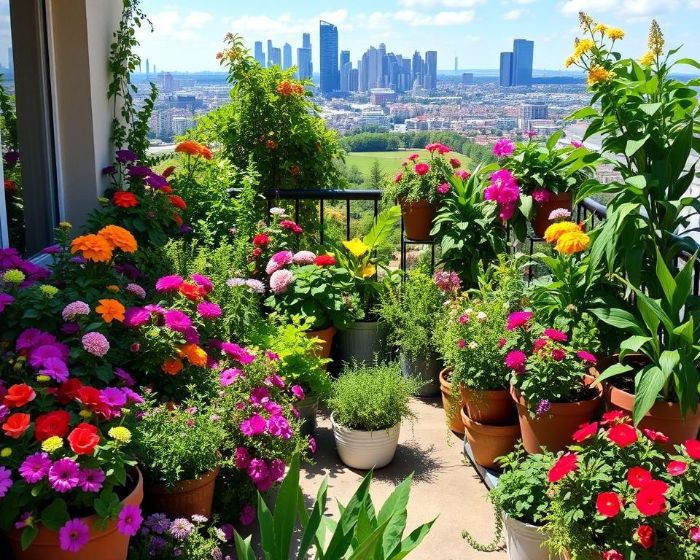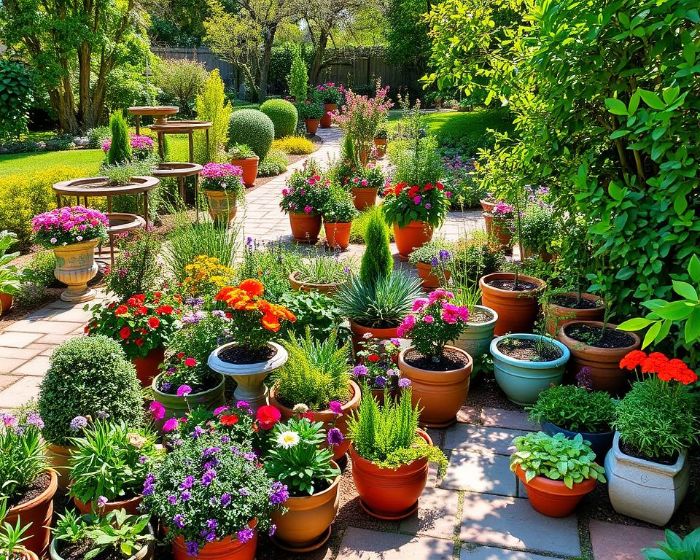Ever thought about how a small tree can show the beauty of a big forest? This idea is at the heart of bonsai gardening. It’s a mix of art and plants. Bonsai art comes from old Asian traditions. It shows the beauty of small trees and teaches us about patience and careful care.
Now, with container gardening, anyone can try bonsai, even if they don’t have much outdoor space. Let’s dive into the world of bonsai. See how you can make your own living art piece.
Key Takeaways
- Bonsai gardening is a blend of art and nature, creating living sculptures.
- Container gardening allows anyone to practice bonsai, regardless of space constraints.
- Understanding tree species and their needs is essential for successful bonsai art.
- The history of bonsai reflects cultural influences from both Chinese and Japanese traditions.
- Patience and observation are key components of cultivating miniature trees.
Table of Contents
Introduction to Bonsai Gardening
Bonsai is a unique blend of art and gardening; exploring advanced cultivation techniques reveals how miniature trees develop beauty in limited space. The name “bonsai” means “planted in a tray” in Japanese. It shows the link between nature and beauty in this hobby.
What is Bonsai? A Brief History
Bonsai has a long history, starting from Chinese traditions over a thousand years ago. Japan later made it into the art we know today. Over time, bonsai experts have used many techniques. This has made bonsai history rich with different styles and ideas.
Why Grow Bonsai in Containers?
Container gardening is key to bonsai; building a foundation in small-scale setups allows anyone to enjoy this art, even with limited space. You can grow bonsai in any space, big or small. Containers make it easy to move your trees around.
Also, growing bonsai in pots helps you be more mindful and creative. You learn to care for and shape your trees.
Selecting the Right Bonsai Tree
Finding the perfect bonsai tree is key for its beauty and upkeep. Beginners should look for species that do well in containers.
Best Tree Species for Beginners
Great bonsai trees for newbies include:
- Japanese Maple
- Zelkova
- Juniper
- Pomegranate
These trees fit well in containers and have beautiful leaves and shapes. Choosing the right tree makes starting with bonsai easier.
Factors to Consider – Climate, Space, and Style
Knowing about climate is important for bonsai care. Tropical trees might need to stay inside when it’s cold. Hardy trees can handle cooler weather outside.
How much space you have is also key. Beginners should think about the size of the pot needed for growth. Different trees have their own styles, which affects how they can be shaped.
Choosing the Perfect Container
Finding the right bonsai container is key to your tree’s health and looks. Size, shape, and material matter a lot. They help your tree grow well.
Size, Shape, and Material Considerations
Choosing the right size is very important. Shallow and wide containers help roots grow well. They keep your bonsai looking small and beautiful. The container’s shape can also make your tree look better. You can be creative with it.
Containers come in different materials like clay, ceramic, and plastic. Each has its own benefits:
- Clay – Great for keeping moisture in and staying stable.
- Ceramic – Comes in many colors and styles, adding beauty to your tree.
- Plastic – Light and affordable, but less traditional.
Importance of Drainage in Bonsai Pots
Good drainage is crucial in bonsai containers. Pots need holes to let water out and prevent root rot. This keeps roots moist but not too wet.
Soil Mix and Potting Bonsai
Creating a healthy bonsai means paying attention to soil mix and potting. The right soil mix is essential for aeration and drainage; adopting recommended container soil blends ensures bonsai roots stay healthy in a confined pot. These are vital for the roots. By picking a mix that holds moisture but also drains well, bonsai owners can help their trees grow strong and look great.
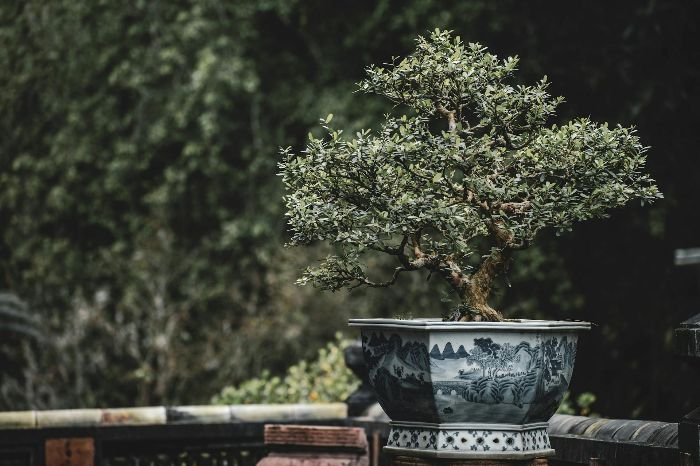
Ideal Soil Composition for Bonsai Trees
The best bonsai soil mix has three main parts:
- Pumice – Great for drainage and air around the roots.
- Lava rock – Helps keep the soil warm and supports root growth.
- Organic matter – Gives nutrients and helps keep moisture in the soil.
This mix helps roots stay healthy and lowers the chance of root rot. Checking the soil often is important. Repotting every two years gives the bonsai fresh nutrients and room for roots to grow.
How to Pot Your Bonsai Tree Correctly
Getting potting right is key for a bonsai’s health. Before putting the tree in its pot, trim the roots to fit. Make sure the main roots are okay and healthy.
When putting the bonsai in the pot, think about how it looks and its health. Angle the tree for a nice look and use wire or moss to keep it in place. Doing this helps with a good potting and makes the bonsai last longer and look better.
Watering and Fertilizing Your Bonsai
Bonsai trees need the right amount of water and food to stay healthy and grow well. It’s important to know how much water and when to feed them. Here are some tips to help you care for your bonsai.
How Much Water Does a Bonsai Need?
Watering bonsai trees is different from watering regular plants. The amount of water they need depends on the type of tree, its size, and where it lives. Here are some important things to remember:
- Check the soil moisture before you water. If the top layer is dry, it’s time to water.
- Use rainwater or purified water to avoid harmful minerals that can hurt the plant.
- Water until water drains from the bottom to make sure the tree gets enough moisture.
Fertilizer Types and Feeding Schedule for Optimal Growth
Feeding your bonsai with the right food is key to its health and color. There are different types of fertilizers, each with its own benefits:
- Organic fertilizers give nutrients slowly, helping the tree grow steadily.
- Synthetic fertilizers can be used at half strength in the growing season for a quick boost.
Feeding your bonsai seasonally can keep it healthy. Knowing what nutrients your bonsai needs helps it grow well and look great.
Pruning and Shaping Techniques
Keeping a bonsai healthy and well-formed relies on pruning basics and shaping methods that respect its natural growth. These steps are key for growth control and making the tree look great. Learning how to prune and wire your bonsai makes creating a beautiful tree easier.
Basic Pruning Tools and Methods
First, you need the right tools for bonsai pruning. You’ll need:
- Specialized bonsai scissors for precise cuts
- Concave cutters for neat trimming of branches
- Rakes and tweezers for managing moss and debris
Using these tools right helps with different pruning methods. For example, cutting back growth should match the tree’s natural shape for balance.
Wiring Your Bonsai – Tips and Techniques
Wiring is key for shaping bonsai branches, though avoiding typical pruning mistakes is just as important for maintaining healthy growth. Here are tips for wiring:
- Choose the right gauge wire – thicker wires work better.
- Wrap the trunk and branches gently to avoid harming the bark.
- Adjust the wire as needed; branches can be moved later.
Wiring correctly can make your bonsai look amazing. It lets you express your creativity and make each tree unique.
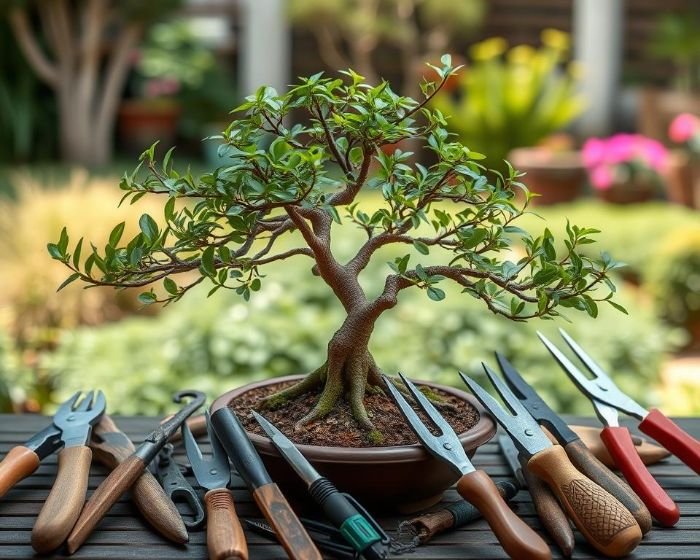
Styling Bonsai for Aesthetic Appeal
Creating a beautiful bonsai means knowing about different styles. Each style lets you show your artistic side while keeping nature’s beauty. It’s a way to express yourself through art.
Popular Bonsai Styles to Try
There are many bonsai styles, each showing a different view of nature and art. Here are some top styles you might like:
- Formal Upright – This style has a straight trunk. It shows strength and stability.
- Informal Upright – It has a slightly curved trunk. This makes it look more natural and relaxed.
- Cascading – This style looks like the tree is falling down. It shows how strong it is against the weather.
Enhancing Your Bonsai with Rocks, Moss, and Miniature Accents
To make your bonsai look better, add natural things like rocks and moss. Rocks give a strong, stable feel. Moss makes it look lush and alive. Adding small figures or structures tells a story, making your bonsai more interesting.
Seasonal Care for Bonsai
Seasonal care is key for keeping bonsai trees healthy and alive. Each season needs its own special care plan. Knowing how to care for your bonsai in winter and summer is important for success.
Adjusting Care for Winter and Summer
In winter, it’s vital to protect your bonsai, especially if they are tropical. Deciduous trees can usually stay outside with little protection. Changing how you water and light your tree is important for its health.
- Keep indoor bonsai near a light source during winter.
- Make sure outdoor pots are off the cold ground to prevent root freeze.
- Check the soil moisture more often in summer since it dries out faster.
Protecting Your Bonsai from Pests and Diseases
Watching for pests and diseases is a big part of caring for bonsai. Catching problems early helps you manage them better. Keeping your bonsai area clean helps keep pests away and lowers disease risk.
“Observing signs such as yellowing leaves or wilting can indicate underlying problems that need addressing.”
Using these strategies will help protect your bonsai and make sure they grow well all year.
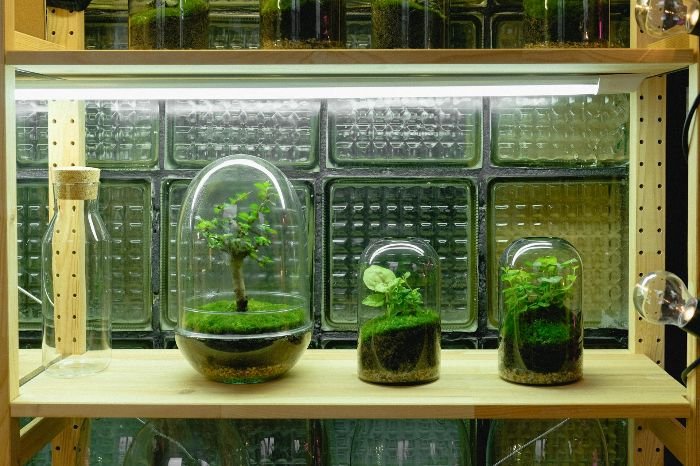
Common Bonsai Problems and Solutions
Bonsai gardening can be tricky. It’s key for gardeners to know how to fix common issues. Problems like yellow leaves and root rot can hurt the health of these small trees. Spotting and fixing these problems early is crucial for their recovery.
Yellowing Leaves, Root Rot, and Other Issues
Yellow leaves often mean you’re watering too much or not enough. Check your watering schedule to see if you need to change it. Making small changes can help your bonsai have healthy green leaves.
Root rot happens when the soil stays too wet, letting fungi grow. You must act fast to fix root rot. This usually means repotting and cutting off any dead roots. You might also need to watch out for pests or stress from the environment.
How to Revive a Dying Bonsai Tree
To save a dying bonsai, start by figuring out what’s wrong. It could be about watering, light, or food. Here are some steps to help:
- Change how often you water to let the soil dry out a bit.
- Look at the roots; cut off any that are mushy or look bad.
- Use the right kind of fertilizer to feed the soil.
- Make sure the tree gets enough sunlight for its type.
By quickly fixing these bonsai care issues, gardeners can bring their trees back to life. This way, they can enjoy their beauty for many years.
Displaying Your Bonsai
Showing off your bonsai means knowing what it needs to thrive. There are many ways to make your bonsai look great. You must think about indoor and outdoor spots to find the best place for your tree.
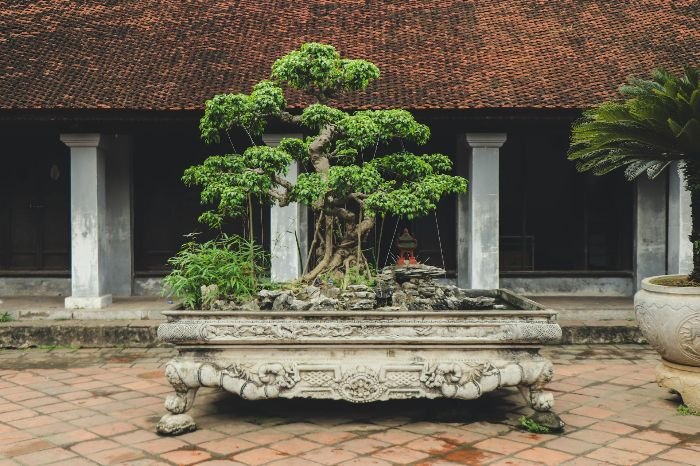
Indoor vs. Outdoor Display Considerations
Deciding where to put your bonsai is important. Indoor bonsai need lots of natural light to do well. Outdoor bonsai like sunlight but need protection from bad weather. You must think about temperature, humidity, and light to make a good home for your bonsai.
Bonsai Stands and Displays to Showcase Your Tree
Using special bonsai stands can really make your tree stand out. These stands let you see your bonsai from all sides, showing off its shape and beauty. Here are some display options:
- Wooden or metal stands for different looks
- Elevated platforms for more depth
- Clear cases for protection and looks
Using these display tips turns your bonsai into a beautiful centerpiece. It shows off the beauty of gardening in pots. Each display tells a story of nature’s beauty and the love for bonsai trees.
Bonsai as a Therapeutic Hobby
Bonsai gardening offers significant health benefits, mirroring mindful horticultural practices that encourage relaxation and deeper appreciation of nature. This hobby teaches patience and mindfulness, which are great for a calm mind.
Watching bonsai trees grow helps people think deeply and find peace. It’s a way to relax and enjoy quiet moments.
The Meditative Benefits of Bonsai Gardening
Looking after a bonsai tree means paying close attention to details. It’s perfect for those who love to meditate. Every cut with the shears or wire on a branch brings you closer to the now.
This focus can make you feel less stressed and happier. It shows how bonsai can be a healing hobby.
Connecting with Nature Through Bonsai
Bonsai gardening helps you feel close to nature, which is good for your mind. It makes you notice and value your trees and the world around them.
This bond with nature teaches you to appreciate life more. It makes you feel responsible for taking care of living things. This leads to a happier and more balanced life.
FAQ
What is bonsai gardening?
Bonsai gardening is about growing small trees in pots. It makes them look like big trees in nature. You need to know about different tree types, how to care for them in pots, and what looks good.
How do I choose the right bonsai tree?
Start with trees that do well in pots, like Japanese Maple or Juniper. Think about the climate, space, and how the tree looks. This helps you pick the best one.
What materials are best for bonsai containers?
The right pot is key for your bonsai tree. Use shallow pots made of clay, ceramic, or plastic. They help the roots grow and keep the tree small. Make sure the pot drains well to avoid waterlogged soil.
How often should I water my bonsai tree?
Water your bonsai tree just right, depending on the type, size, and where it’s kept. Use rainwater or purified water to avoid hard minerals. Check the soil often to see if it needs water.
When should I prune my bonsai tree?
Pruning is key for shaping your bonsai. When to do it depends on the tree type. Prune regularly to keep your tree healthy and looking good.
What are some common problems when growing bonsai?
Bonsai trees can face issues like yellow leaves, root rot, and slow growth. Yellow leaves might mean too much water or not enough nutrients. Root rot needs quick action, like repotting and trimming roots. Spotting problems early helps fix them faster.
How can I display my bonsai effectively?
Show off your bonsai in a way that makes it look great. Indoor trees need lots of light. Outdoor ones like sun but might need shade. Use special stands to show off your tree from different views.
What are the therapeutic benefits of bonsai gardening?
Bonsai gardening is good for your mind and soul. It teaches you to be patient and mindful. Watching your tree grow and shape it connects you with nature. It helps you relax and feel calm.









